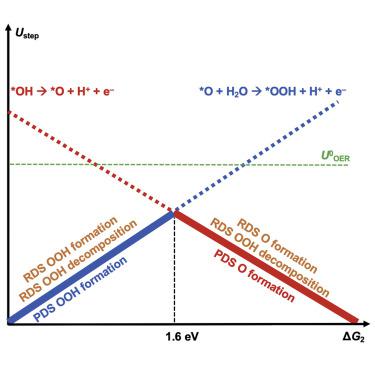Chem Catalysis ( IF 11.5 ) Pub Date : 2021-07-15 , DOI: 10.1016/j.checat.2021.06.011 Kai S. Exner 1, 2, 3

|
In the last decade, tremendous efforts have been dedicated to the breaking of the OOH versus OH scaling relation, which is recognized as the bottleneck for electrocatalysts in the oxygen evolution reaction (OER), the anodic process in water electrolyzers. Breaking the OER scaling relation is seen as a universal remedy to enhance electrocatalytic activity, yet no major progress has so far been achieved in the design of improved OER materials according to this strategy. Introducing kinetics into the thermodynamics-based concept of scaling relations illustrates that the breaking of the OER scaling relation could be accompanied by decreased electrocatalytic activity. As a consequence, it appears imperative to progress the theoretical description of the OER in different directions other than the breaking of this scaling relation. This could include the investigation of competing mechanistic pathways, concerted and decoupled proton-electron transfer steps, or microkinetic considerations in conjunction with machine-learning approaches.
中文翻译:

为什么 OOH 与 OH 比例关系的破坏可能会导致电催化活性降低
在过去的十年中,人们付出了巨大的努力来打破 OOH 与 OH 的比例关系,这被认为是水电解槽阳极过程中析氧反应 (OER) 中电催化剂的瓶颈。打破 OER 比例关系被视为提高电催化活性的通用补救措施,但迄今为止,根据该策略在改进 OER 材料的设计方面尚未取得重大进展。将动力学引入基于热力学的比例关系概念表明,OER 比例关系的破坏可能伴随着电催化活性的降低。因此,除了打破这种比例关系之外,似乎必须在不同方向上推进 OER 的理论描述。











































 京公网安备 11010802027423号
京公网安备 11010802027423号